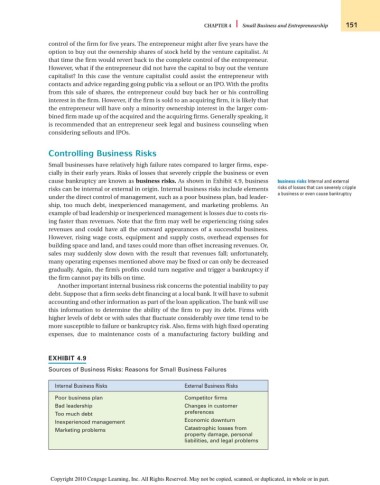Page 177 - Introduction to Business
P. 177
CHAPTER 4 Small Business and Entrepreneurship 151
control of the firm for five years. The entrepreneur might after five years have the
option to buy out the ownership shares of stock held by the venture capitalist. At
that time the firm would revert back to the complete control of the entrepreneur.
However, what if the entrepreneur did not have the capital to buy out the venture
capitalist? In this case the venture capitalist could assist the entrepreneur with
contacts and advice regarding going public via a sellout or an IPO. With the profits
from this sale of shares, the entrepreneur could buy back her or his controlling
interest in the firm. However, if the firm is sold to an acquiring firm, it is likely that
the entrepreneur will have only a minority ownership interest in the larger com-
bined firm made up of the acquired and the acquiring firms. Generally speaking, it
is recommended that an entrepreneur seek legal and business counseling when
considering sellouts and IPOs.
Controlling Business Risks
Small businesses have relatively high failure rates compared to larger firms, espe-
cially in their early years. Risks of losses that severely cripple the business or even
cause bankruptcy are known as business risks. As shown in Exhibit 4.9, business business risks Internal and external
risks can be internal or external in origin. Internal business risks include elements risks of losses that can severely cripple
a business or even cause bankruptcy
under the direct control of management, such as a poor business plan, bad leader-
ship, too much debt, inexperienced management, and marketing problems. An
example of bad leadership or inexperienced management is losses due to costs ris-
ing faster than revenues. Note that the firm may well be experiencing rising sales
revenues and could have all the outward appearances of a successful business.
However, rising wage costs, equipment and supply costs, overhead expenses for
building space and land, and taxes could more than offset increasing revenues. Or,
sales may suddenly slow down with the result that revenues fall; unfortunately,
many operating expenses mentioned above may be fixed or can only be decreased
gradually. Again, the firm’s profits could turn negative and trigger a bankruptcy if
the firm cannot pay its bills on time.
Another important internal business risk concerns the potential inability to pay
debt. Suppose that a firm seeks debt financing at a local bank. It will have to submit
accounting and other information as part of the loan application. The bank will use
this information to determine the ability of the firm to pay its debt. Firms with
higher levels of debt or with sales that fluctuate considerably over time tend to be
more susceptible to failure or bankruptcy risk. Also, firms with high fixed operating
expenses, due to maintenance costs of a manufacturing factory building and
EXHIBIT 4.9
Sources of Business Risks: Reasons for Small Business Failures
Internal Business Risks External Business Risks
Poor business plan Competitor firms
Bad leadership Changes in customer
Too much debt preferences
Inexperienced management Economic downturn
Marketing problems Catastrophic losses from
property damage, personal
liabilities, and legal problems
Copyright 2010 Cengage Learning, Inc. All Rights Reserved. May not be copied, scanned, or duplicated, in whole or in part.

